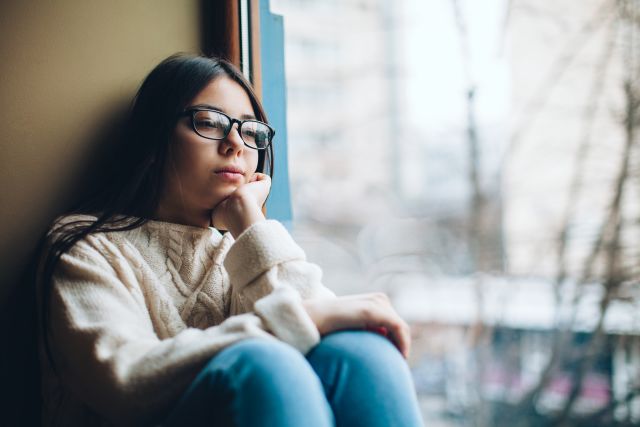Updated on November 3, 2020.
After nearly a year, the COVID-19 pandemic has eroded the mental health and overall well-being of millions of people. In the United States, rising case counts paint a grim picture for the long winter ahead—a time when many people struggle to cope with shorter, darker days.
This winter could be especially difficult for those susceptible to seasonal affective disorder (SAD), a form of depression that's tied to changes in the seasons. For most people with SAD, symptoms appear in the fall as the days grow shorter and can persist throughout winter.
With no clear end to the pandemic in sight, anxiety among Americans is brewing, according to Ani Kalayjian, EdD, a psychotherapist and adjunct professor of psychology at Teachers College, Columbia University in New York City. “It’s definitely going to be a challenge this year since we’re already struggling with a lot of emotional issues as a result of the physical isolation,” she says.
SAD is more than ‘winter blues’
Sometimes brushed off as the “winter blues,” SAD is more than missing summer or having a bad day. Scientists are still working to understand what causes the condition.
Research suggests that people with SAD may have reduced activity of the brain chemical serotonin (the “feel good” hormone that helps control mood).
Sunlight plays a role in how serotonin levels are regulated. There is some evidence that this regulation doesn’t occur properly in people with SAD and levels of the hormone may drop during winter.
Reduced exposure to light during fall and winter could also trigger an imbalance in melatonin levels. There is evidence that people with SAD produce too much of this hormone. This can make people feel sleepy when they would normally be more alert.
Vitamin D deficiency, which is more common in winter, could be another contributing factor. Vitamin D is believed to support serotonin activity. People with SAD may have lower than normal levels of this essential nutrient, which could result in low serotonin activity and changes in mood.
People with SAD may experience symptoms of depression, including:
- Feeling sad or down most days
- Losing interest in once enjoyable activities
- Feeling tired or having little energy
- Having trouble sleeping
- Experiencing changes in weight or appetite
- Feeling irritable
- Having problems concentrating
- Feeling hopeless, worthless or guilty
- Having thoughts of death or self-harm
Particularly during winter, people with SAD may oversleep, overeat (particularly carbohydrate-rich foods), gain weight, feel overly tired and want to withdrawal socially or hibernate.
A double whammy this year
An estimated 17.3 million people, or about 7 percent of all U.S. adults, had at least one major depressive episode, according to data compiled in 2017 by the National Institute of Mental Health.
Research suggests, however, that more Americans are struggling with depression since the pandemic began. A September 2020 survey published in JAMA polled 1,441 people during the pandemic and 5,065 before the emergence of COVID-19. Researchers found that the prevalence of symptoms of depression is more than three-fold higher now than it was pre-pandemic. They noted that people who were already at higher risk for depression—even before the time of COVID-19—are among the most vulnerable now.
Meanwhile, some 10 million Americans are affected by SAD. This seasonal form of depression is diagnosed four times more often in women than men. It’s also more common among younger adults and people who live farther from the equator. Those with a personal or family history of SAD or depression are also more likely to be affected.
The psychological toll of the ongoing pandemic and related economic stress and uncertainty may be a double whammy for those who must also brace for SAD.
Cold weather keeps people at home for longer periods and often means less exposure to natural light and more isolation. That’s especially true now as many people who’ve managed to socialize in a physically distanced way outside are forced to retreat indoors.
Managing SAD amid the pandemic
Depression is one of the most treatable mental health issues, according to the American Psychiatric Association. In some cases, people can help ease their symptoms with lifestyle adjustments, including exercising regularly, getting adequate sleep, eating a healthy diet and limiting alcohol consumption.
Establishing a healthy routine and sticking to it can also help, according to Kalayjian. As much as possible, follow the same daily schedule. Eat your meals, wake up and go to bed around the same time each day. If you’re working remotely, set clear boundaries between work and home. This includes not working in your bed.
Use your imagination to clear obstacles that may prevent you from following through on your plans. For example, if going to the gym isn’t possible, use what’s available to you, Kalayjian says. When she was unable to find free weights for purchase online, she used paint gallons in her garage to do bicep curls.
“These times require creativity and coming out of a set box of expectations,” Kalayjian says. “Mobilize the resources you have.”
It may also be helpful to start the day by writing down any negative thoughts or feelings on paper—a daily assignment that Kalayjian calls “morning pages.”
“Sit down with your tea or coffee or green juice and write a whole page, no punctuation. Just fill the page with any emotions,” she says. Then, throw the paper away. “Don’t examine what you release. It’s just the discharge.” This writing exercise can help prevent unreleased emotions from negatively affecting the body, Kalayjian explains.
It’s also important to find ways to stay connected. Despite the need to physically distance ourselves from people outside of our immediate family to help contain the spread of COVID-19, it’s still possible to socialize, according to Kalayjian. “We’re social animals,” she says, noting that people need contact with others.
Keep in touch with friends over video conferencing platforms, like FaceTime or Zoom, or on the phone. Communicate with friends, family or neighbors in person—but from a safe distance of at least 6 feet.
A break from the news may be in order as well. Consider limiting how much you listen to, watch or read—especially coronavirus-related news. When you hear about the pandemic incessantly, it can be upsetting and negatively affect your mood, Kalayjian cautions. It’s also important to listen to only credible, trustworthy news sources, reporting accurate, up-to-date information.
There are some additional strategies to help people cope with SAD, including:
Get outside—even for a brief time. The body has a self-sustaining 24-hour internal clock (also known as your circadian rhythms) that responds to daylight and darkness to tell us when we should be awake and when it’s time to be sleepy.
Your body clock helps keep you asleep at night and feeling wakeful during the day. Light is one of several external factors that can affect how it functions. Your body clock may be disrupted during the darkness of winter, which may be linked to a variety of health consequences, including mood changes. Increasing your exposure to natural light outside could help minimize this disruption.
The body also creates vitamin D from direct exposure to sunlight on the skin. So, getting outside can help prevent a deficiency in this important nutrient.
Take advantage of mild weather and spend more time outside walking, running or simply enjoying nature. When temperatures drop, it’s still important to try and step outdoors each day. Be sure to stay warm by dressing in layers and wear a hat and gloves. If you have asthma or COPD, you should also cover your mouth and nose with a scarf. Even a short walk or sitting outside for 30 minutes per day could help. If possible, aim to get at least some exposure to light in the morning.
Commit to a healthy diet. People with SAD often crave unhealthy carbohydrates, which can contribute to weight gain. “Almost 90 percent of my clients have reported gaining weight, and that feeds into low self-esteem and depression” Kalayjian says. Focus on eating a heart-healthy diet that emphasizes a variety of fruits and vegetables.
Know when to seek help. Increasing your exposure to natural light by spending more time outside and allowing more sunlight into your home through windows can help ease mild SAD. But more severe cases may require additional treatment under the guidance of a mental health professional.
For some people, light therapy may provide more relief from their symptoms. This therapy involves sitting in front of a very bright light every day for 30 to 45 minutes. It’s usually done first thing in the morning, starting in the fall and continuing until spring.
The artificial light is about 20 times brighter than regular indoor lighting. Potentially damaging UV light is filtered out, making it a safe therapy for most people. Keep in mind, this is not a substitute for natural light—only a supplement. The light intensity of a sunny day is about five times greater than light therapy.
In some cases, a combination of antidepressant medication and cognitive-behavioral therapy may also be recommended.
If you or someone you care about needs mental health support as the pandemic continues and winter sets in, don’t let worries about infection and the need for social distancing prevent you from seeking support from a mental health professional.
By taking advantage of telemedicine, most people with Wi-Fi and a smartphone, tablet or computer can “see” a healthcare provider virtually for medical advice and keep follow up visits without leaving their home.
Telemedicine includes mental health care. In fact, teletherapy, or virtual therapy, has emerged as a vital resource for a growing number of people during these uncertain times.
Recognize an emergency
If you feel your depression is severe or if you are having thoughts of suicide or self-harm, seek help at the closest emergency room or reach out to the Crisis Text Line by texting ‘HELLO’, ‘HOME’, START’ or ‘NAMI’ to 741741.
You will be connected with someone who will listen to your concerns without judgment. You can also call the National Suicide Prevention Lifeline at 1-800-273-8255 or call, text, or chat 988.






